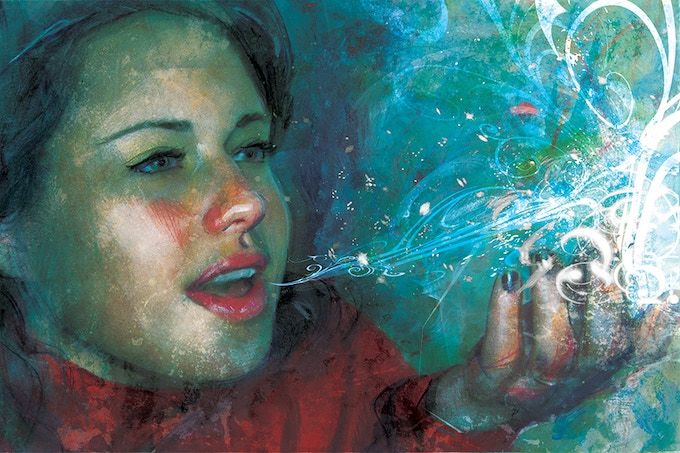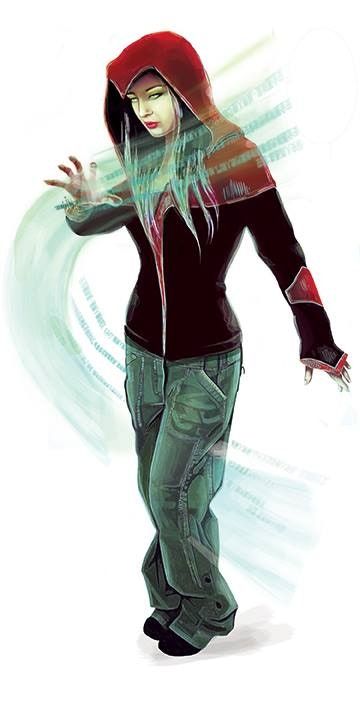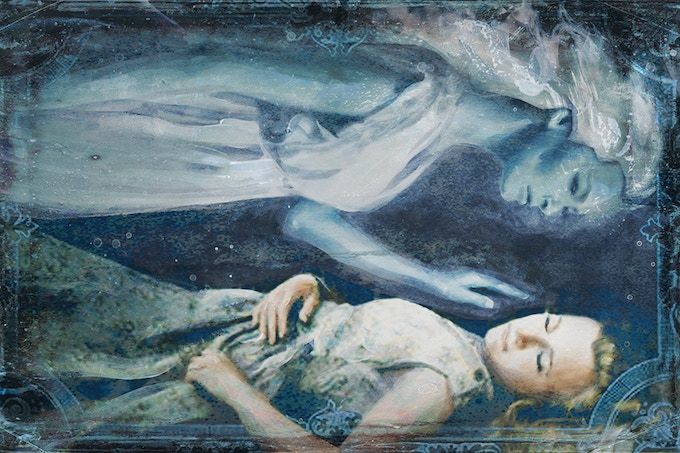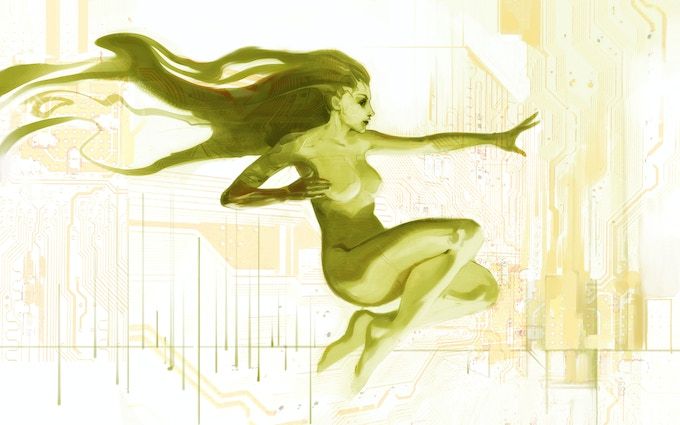Mage: The Ascension - A game system overview
Among the masses of RPG material being published right now, it can be hard to find the really good games. Here's one recommendation from us...

Would you like to be a hero, cast an endless variety of magic spells, dodge bullets matrix-style, delve into occult secrets, engage in fantastic martial arts fights, move mountains with your faith, go on voyages into strange worlds with steampunk technology, be the agent of a great benevolent conspiracy, or use cutting edge science to benefit mankind? Well, look no further!
Mage – The Ascension gives you the possibility to do all that, and more!
Mage – The Ascension is a roleplaying game (or "storytelling game", as White Wolf Publishing calls it), a part of the greater World of Darkness setting, and encompasses several genres, from urban fantasy to science fiction. The World of Darkness is a "gothic punk" mirror of our own, real world - a shadowy version of it, in which everything seems to have taken a turn for the worse. In most World of Darkness games, you “play the monster”, like a vampire, werewolf, or wraith.
In Mage, the characters are paranormal too. But most of the time, although they are pretty extraordinary, you play relatable people. And while the game can still be - if you want it to - very dark, Mage is one, if not the most hopeful game of the bunch. Mages are people who care, in a growingly depressing and stale world. Many of them follow esoteric worldviews, and the setting has a rich background with a good dose of real-world satire, making Mage a game that can be quite deep, even philosophical.
Background – the “Fluff”
Is this the real life? Is this just fantasy? Who cares! Reality is subjective. Well, at least, in Mage it is. In Mage metaphysics, the consensus of normal people's perception constitutes reality. These people are called sleepers, as they are unaware of their collective power and/or unable to use it. There are, however, humans (or more specifically, their "avatars") who awaken to this truth, and who have the ability to do extraordinary things by using their beliefs and their willpower, often bending or flat-out breaking the rules that the sleeper’s consensus sets. These people work towards individual and global Ascension. These people are mages.
The avatar is the immortal part of an individual's soul, connecting them with eternity and driving them towards awakening and ascension. A mage's avatar can communicate with them in many forms, from a spirit mentor or fairy godmother to a chat partner which the mage regularly meets on the net, guiding him in reformatting reality.
Unfortunately, consensual reality, made from billions of sleepers beliefs, doesn't appreciate mages breaking its rules ("vulgar magic"). If pushed too hard, it defends with a mechanism called "paradox", causing supernatural effects or sending special "paradox spirits" to punish the transgressor. Mages often fare better casting only small changes that are plausible within the rules of the consensus, which are called "coincidental magic".
Mages, following different aberrant beliefs that separate them from the rules of the consensus, are also a quarrelsome bunch. And so, the Ascension War began, which lasts on to the modern day – with magical societies battling each other, trying to convince sleepers of their respective take on how reality should be and guide them towards their respective take on collective Ascension. Classically, there used to be four factions, but in Mage 20, a fifth one has formed.

Factions in Mage
The Nine Mystic Traditions
The first of the two major factions are the “Nine Mystic Traditions”, nine paths of life for mages that are pretty much what you would expect, except for a few surprises:
- The Order of Hermes (hermetics)
- the Dreamspeakers (shamans)
- the Verbena (witches who follow the old ways)
- The Celestial Chorus (religious wonderworkers)
- the Virtual Adepts (Hackers)
- The Akashic Brotherhood (eastern martial artists)
- the Euthanatos (death mages... yes, death mages)
- The Cult of Ecstasy (mages who employ trance as their main tool... a.k.a. "the party tradition"), and
- the Sons of Ether (proponents of discredited scientific theories: light ether, phlogiston... It's mind-blowing - look it up!)
Individuality, creativity, and overall freedom are what these people stand for… oh, and occultism, of course. Playing a Tradition mage was, for most of the system's existence, the basic choice, and still is at the core of what the game is about.

The Technocratic Union
The other, and the most successful major faction, is the "Technocratic Union" or Technocracy. The Technocracy is a strictly regimented secret organization of Scientists (Don’t call them “mages”!) and dedicated agents who work on making the world more orderly and sterile, well-regulated, and less dangerous to the masses. Think Men in Black. There actually are Technocrats called Men in Black, and yes, they are great fun to play...
Those Tradition weirdos want some magical fairytale reality? Well, ask any sane sleeper if he wants a world without natural laws where they can practically be eaten by demons anytime. The reality police, err, I mean, Technocracy is here to save you and to preserve science and truth… and all it’ll cost you is your personal freedom.
Where the Mystics have Traditions, the Technocracy has five Conventions. These are
- the NWO (yes, the New World Order). They try to strengthen reality with institutions and academia, but also employ the aforementioned Men in Black
- Iteration X (posthumanist technicians, some of them cyborg fanatics who used to worship what they thought was the first real A.I.)
- the Progenitors (doctors, gene engineers, and biochemists - nothing to see here, not even one mad scientist, cough)
- The Syndicate (Non-apologetic capitalists who use... and shovel in... the one thing that every sleeper believes in - money), and
- the Void Engineers (Spacefarers and Explorers).
In the first and much of the second edition, Technocrats used to be the standard villains of the Mage setting. However, they have gradually been made a little more playable, relatable, and less evil. Nothing wrong with a little science and objectivity, right? Then again, maybe their organization is infiltrated by Nephandi... who, you say? Keep reading.
The Disparate Alliance
Apart from these two big factions, there always were the disparate “crafts” – magical societies in their own right, who were, however, not successful enough or simply not interested to join either the Traditions or the Technocracy. In Mage 20, these crafts have formed their own, secret “Disparate Alliance”. The Disparates are the most diverse, least organized, and least eurocentric faction of the three. Their ranks include such groups as
- the Sisters of Hippolyta (Amazon healers)
- the Templars (who have continued to exist as a secret society after their downfall in medieval France)
- the Ahl-i-Batin (also called the Subtle Ones, Sufi mystics who pursue Unity)
- the Children of Knowledge (alchemists)
- Taftâni (pre-Islamic oriental mages who just love vulgar magic)
- the Hollow Ones (gloomy, late rising goths)
- the Ngoma (ritualistic, Subsaharan-African mystics)
- the Bata'a (Voudoun and Voodoo practitioners)
- Kopa Luei (Hawaiian mystics), and
- the Wu Lung (Confucian dragon wizards who work with the celestial bureaucracy).
The Alliance also includes a hefty dose of Orphans, mages who didn't join a Tradition or Convention and practice their own style.
Others - Marauders and Nephandi
Mages tend to attract interesting events, so they usually have the best chances of getting punched, shot, thrown from buildings, or mashed into a fine paste scattered over several dimensions. But as if that wasn't making life as a mage chaotic enough anyway, there are two more factions to consider in the Ascension War. They are, however, for the most part, not playable characters.
One of these groups is the Marauders - mages of different origins who have become so detached from reality that they've gone, to varying degrees, mad. Unfortunately, they still are mages, and they keep constantly "rewriting" reality around them. Not that a sleeper would realize it, but still - it sucks to be a living doorknob in someone else's reality.
The last, and most dangerous, faction is the Nephandi - mages who have, for various reasons, left the pursuit of Ascension and now work actively on shoving the world down the abyss. In previous editions, Nephandi usually fell into the broad categories of
- Infernalists (who have made a pact with dark powers... like Satan, at least if they lack creativity)
- Malfeans (who have committed themselves to the Wyrm, a corrupted entity that embodies entropy, originally from Werewolf - The Apocalypse), and
- K'llassha (who serve powers from beyond the solar system, and those are really, really strange... did someone say Cthulhu? Not the Mage rulebooks of course...)
Nowadays (and with Mage 20) however, there are more Nephandi outside these categories... which tends to make them even more dangerous, as Traditions and Technocracy are more likely to overlook them until it's too late. The new, improved Nephandi spectrum ranges from heartless mercenary organizations (*cough*ckwater) to evil awakened internet users who try to spawn Roko's basilisk. No, I didn't make this one up, there really is a thought experiment with that name. Google it at your own peril.
The Tellurian - the universe of Mage
Due to the consensual nature of reality in Mage, the setting offers endless possibilities. After all, even the most rational people are guilty of a little magical thinking once in a while... plus, even in the modern world, not everybody is rational. So while natural laws exist, so do several dimensions, myriads of different spirits, the ghosts of the dead, and a place for creatures such as vampires, werewolves, and sorcerers (which is not the same as mages in the game)... all outside the knowledge of sleepers.
The Umbra - three worlds, limitless realms
The spirit realms aren't anything if not complex. This is a simplified explanation for something that has been expanded upon in several sourcebooks: The three worlds (or dimensions) of the Umbra underlie the material world like a shadow (hence the name). They mirror our reality, so that every location in the solar system has an equivalent in each of the three worlds, but there are also separate realms in each world that often embody concepts or feelings... or that just give us the possibility to explore weird fantasy or science fiction settings. Outside the solar system (the near Umbra), the deep Umbra begins, where the several metaphysical worlds are a lot closer to each other and thus, the world can be even weirder.
The three worlds are the High or Astral Umbra (abstract concepts and thoughts), the Middle Umbra (reflecting the natural environment, both pristine and the toxic cesspool it's become), and the Low Umbra (the underworld, home to the spirits of the dead).
The Umbra is separated from the material world by the Gauntlet, a spiritual barrier making sure reality stays where it belongs, and slimy, mind-eating nightmare creatures from the Umbra stay out. In the first and second edition (before 1998), the Gauntlet was comparatively easy to pierce through, so that Tradition Dreamspeakers and Technocrat Void Engineers, both experts in spirit magic (even though the Technocrats call it dimensional science) were able to visit and/or colonize several realms in the Umbra.
That all changed with the coming of the avatar storm. The avatar storm was a metaphysical event in the revised edition (as the third edition of the White Wolf games was called) connected to events in the metaplot of Mage and several of the other games, which hardened the Gauntlet, shutting many remaining supernatural elements out and separating earthly mages from their masters, colonies and fortresses in the Umbra. Mage in the revised edition was a lot more about urban fantasy. Mage: The Ascension 20th Anniversary Edition (aka “Mage 20” or “M20”) is ambivalent about the metaplot, however - it's left to you to decide if the avatar storm may have subsided by now, or could never have happened at all.
Another concept in the Mage metaphysics are "zones", independent areas between the various Umbrae, with completely unique rules or physics. One of these zones is the Digital Web, an esoteric virtual reality of which the sleeper's modern internet is the tip of the iceberg. The Digital Web is one of the battlegrounds of the Ascension War, and has kept on changing rapidly during the last 30 years. It's the inofficial home of the Virtual Adepts tradition, but the technocratic conventions also have a strong presence.
Umbrood and other creatures
Mage offers lots and lots of strange and sinister encounters. The rulebook defines many classes of allies and opponents, which are expanded upon in M20 - Gods & Monsters. Don't think of the system as hack and slay, though - even though fighting can be an important part of your game, opponents usually are real characters and serve a purpose in storytelling.

Spirits from the Umbra are generally called "Umbrood", divided into several classes. There are also spirits called "Naturae", embodying spiritual concepts of the earth. Djinns form a separate category.You don't have to visit the spirit world to meet interesting creatures, though: others are part of the physical world, like the "HIT Marks", cyborgs that the Technocracy uses as shock troops, or the various results of genetic engineering. A mage could have a familiar. Or meet vampires, werecreatures, or ghosts. And don't forget the sleepers - not every critical situation needs magic, and the damage that a single corrupt police officer or religious fanatic can do in the story might surprise you. There even is a sourcebook (under the unofficial Storyteller's Vault label) dealing with mundane people gone bad, called "Fallen Companions" - detailing the mindset, the rules and background of such fallen sleepers. In my opinion, this is where Mage really gets dark and scary.
Apart from all that there is the mysterious and secret "threat null", recognized only by the Void Engineers. What threat null is? That would be telling. Read the Convention Book Void Engineers or the recently published Technocracy Reloaded. ;-)
Rules – the “Crunch”
Mage uses White Wolf's Storyteller System, initially developed in the early nineties. It's a dice pool system with D10. A character is defined by nine attributes (physical, social, and mental), by the more detailed abilities, and by other advantages like health levels, willpower, backgrounds, and optional merits and flaws.
For mages, one of the most important game features is of course the sphere system of magic. This system offers a broader and more flexible framework for magic than the spell lists in many other systems. The descriptions of the nine spheres (Correspondence, Entropy, Forces, Life, Matter, Mind, Prime, Spirit, Time), in which most mages can have values from 1 to 5, detail the way mages can influence reality, but the effects must also be compatible with the mage's paradigm (his set of beliefs about magic and reality) and, ideally, their foci or instruments of magic. Virtual Adepts, for example, will not be able to spontaneously turn an enemy into an armchair by chanting demon's names - it just wouldn't make sense to them.
Mages start with an affinity sphere, which is their chosen field, most often determined by the tradition or convention they belong to.

Mage: The Ascension FAQs
Learning a new game like Mage: The Ascension can be daunting. There are so many questions that come up when you're learning a new game, it's hard to know where to start. Our FAQs for Mage: The Ascension will help answer all your questions and get you on your way to becoming a master of the game.
What is the difference between Mage The Ascension and Mage The Awakening?
In 2004, White Wolf, the creators of Mage The Ascension and the World of Darkness, put an end to the setting by plunging their world into the apocalypse, an event that had been hinted at from early publications onwards. However, the publisher did not take long to offer a replacement: Like for other game lines (Vampire, Werewolf, etc.), a new Mage setting was released soon after the cataclysm of the old World of Darkness. Fluff-wise, the new game, Mage The Awakening, did not have much in common with its predecessor. While in Ascension, magic is deeply rooted within the structure of reality and has many sources, Mages in this setting are the descendants of the lost city of Atlantis. The crunch of Awakening clearly has a lot in common with Ascension, although the sphere system of magic was heavily modified.
Like other new World of Darkness games, Mage The Awakening was not as successful as the originals, so in 2013, the 20th Anniversary Edition of Mage The Ascension came out, a celebration and rejuvenation of the classical game. Mage The Awakening still exists though, as part of the “Chronicles of Darkness” line.
When did Mage The Ascension come out?
The game’s first edition was published in 1993. The current 20th Anniversary Edition (“Mage 20” or “M20”) began in 2013 with the new rulebook and has since then been expanded with further sourcebooks.
How does a mage awaken?
There are many paths to Awakening, as all Traditions have their own way of teaching and testing their apprentices. Some Traditions, such as the Order of Hermes or the Verbena, have very structured and formal methods, while others, like the Ecstatics or the Cult of Ecstasy, place a greater emphasis on personal experience.
How do you make a Mage The Ascension character?
The first step is to choose a Tradition, as each has its own unique worldview and approach to magic. Once you have chosen a Tradition, you will need to select your Attributes, Abilities, and Backgrounds, and decide on your character’s magical Path. Finally, you will need to obtain your initial magical knowledge from the Spheres of Magic.
Is Mage The Ascension good?
A clear and resounding yes! The possibilities of the Mage setting are limitless! So get cracking and play!

